Intel Thunderbolt 4 Update: Controllers and Tiger Lake in 2020
by Dr. Ian Cutress on July 8, 2020 9:00 AM EST- Posted in
- CPUs
- Tiger Lake
- USB4
- Thunderbolt 4
- TB4

Wired connectivity is converging onto two standards: USB4 and Thunderbolt 4. Both of these are set to debut by the end of the year in Intel’s upcoming Tiger Lake platform, and to set the scene Intel is updating us on the scope of its Thunderbolt 4 efforts.
Thunderbolt 4 is going to be a superset of TB3 and USB4, meaning that any Thunderbolt 4 Type-C host will be able to accept TB4, TB3, USB4, and USB 3/2/1 connections. Thunderbolt 4 will offer speeds up to 40 Gb/s, and there are a number of requirements for Thunderbolt 4 hosts and devices in order to be certified.
These requirements include:
- Video, support 2x 4K or 1x 8K (No detail at what refresh/bit-rate/chroma)
- Data, PCIe at 32 Gbps (storage up to 3 GB/s)
- Support for TB4 docks with four TB4 ports (one upstream, 3 downstream)
- PC Charging on at least one port (for laptops up to 100 W)
- Wake from sleep by peripherals connected to a TB4 dock
- Requires Direct Memory Access protection (more on this later)
The first devices to come to market with TB4 support will be Intel’s Tiger Lake platform, for use in laptops, which will have TB4 baked right into the silicon. TB4 will be one of the base requirements for Intel’s Project Athena certification program, and Intel is set to release a new TB4 2m cable for most use cases. Intel is also working on optical 5-50 meter cables, which will also now support the TB4 multi-port accessory architecture, enabled by 4-port TB4 hubs.
There will be two host controllers, known as Maple Ridge JHL8540 and JHL8340, for use as host controllers in desktops, workstations, and laptops. We are told the package size and power requirements are essentially in-line with previous Titan Ridge TB3 controllers. The device controller, for use in docks, monitors, storage devices and such, is the Goshen Ridge JHL8440. All three of these controllers will be available by the end of the year.
Thunderbolt 4 has no costs associated with using it, the branding, or the logo, however there is a branding/logo license. Intel has opened up the TB4 standard, but as it stands is the only company that has publically announced its intention to make host and device controllers. The cables will be branded with the Thunderbolt Logo and a number 4, however ports on systems will only have the Thunderbolt Logo, making TB3 and TB4 use indistinguishable (we disagree with Intel that users don’t check what their system uses so using the same logo makes no difference to these users – we think the same argument can be used in order to showcase the logo on devices with the number 4).
Here’s a main slide showcasing the difference between all the different standards. Ultimately TB4 is backwards compatible with TB3 and USB4/3/2/1 standards.
One of the key focal points in our briefings with Intel is that Thunderbolt 4 will have an additional requirement this time round – Direct Memory Access protection to prevent physical attacks. In our briefing (and shown on the slide below), Intel initially stated that this requires Intel VT-d technology, which raised questions about Thunderbolt 4 being limited to Intel only systems.
The spokesperson later clarified that in order to gain certification, DMA protection is required, and Intel is using VT-d to do it. Intel refused to comment on how other vendors might implement DMA protection, stating that it would be up to them. While additional security protections are always a good thing, they ideally need to be based around open vettable standards, something which might limit Thunderbolt for another generation as an Intel-only technology (whereas USB is far more ubiquitous).
We’ve reached out to AMD late in the day, and they’ll be supplying a comment soon. I will update this post when I get something.
Update, AMD says the following:
The “Zen 2” architecture supports DMA security in pre-boot and OS environments via AMD-Vi (IOMMU) on USB and PCIe interfaces.
When asked specifically if AMD-Vi meets the requirements for TB4, AMD stated:
If the question is to do we support DMA? The answer is yes. Any questions about if this would satisfy another companies requirements for an interface they are developing would need to be directed at them.
When we asked Intel to confirm if AMD-Vi met the requirements for TB4's DMA protection, we were given the following quote:
Thunderbolt is open to non-Intel-based systems. Like any other system, devices must pass Thunderbolt certification and end-to-end testing conducted by third-party labs. Thunderbolt 4 requirements include Intel VT-d based or an equivalent DMA protection technology that provides IO virtualization (often referred to as IO Memory Management Unit or IOMMU), as well as OS implementation support. If the equivalent technology supports prevention against physical attacks, then that should meet the requirement.
Overall, TB4 seems like a very capable standard, providing backwards compatibility, top class speeds, as well as new connectivity topologies. It will be interesting to see what the additional cost of adding TB4 onto various systems will be with Intel’s controllers, especially in the desktop space.



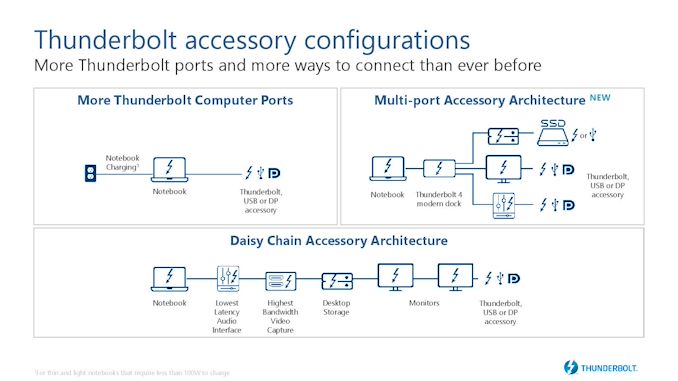
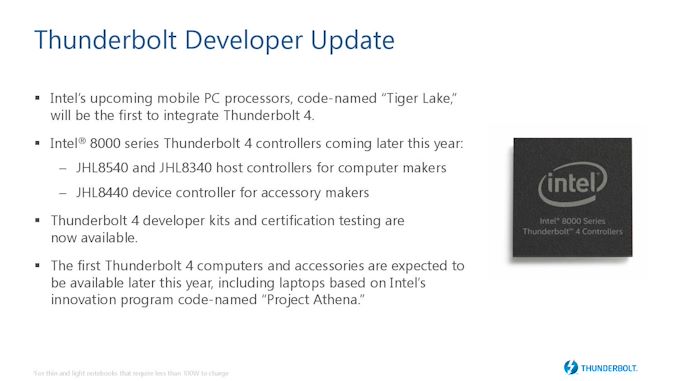

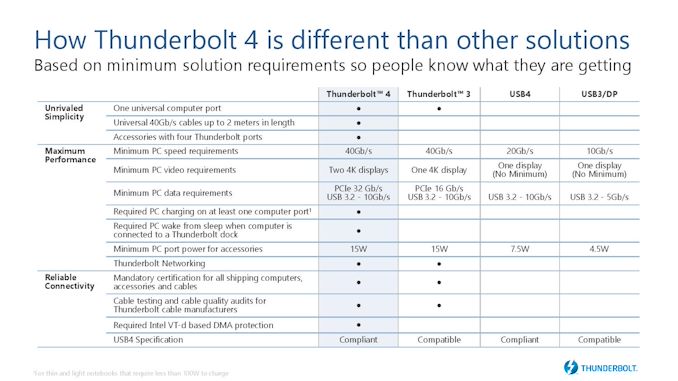
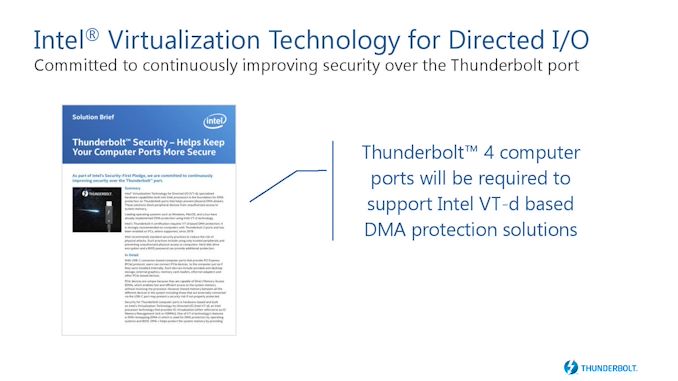
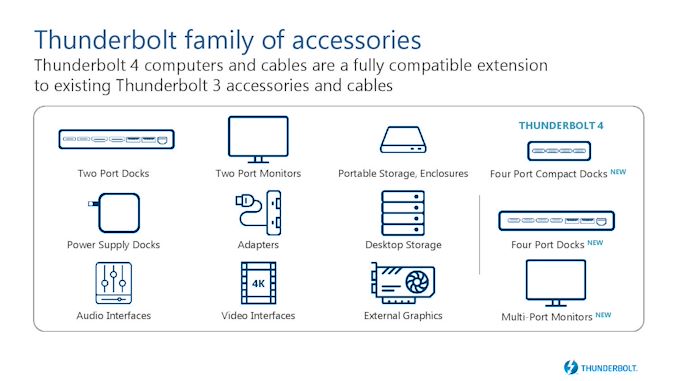














76 Comments
View All Comments
schizoide - Wednesday, July 8, 2020 - link
Originally TB4 was rumored to be 4 lanes of PCIe 4.0, which would double the bandwidth. That extra bandwidth would have been very useful for eGPU purposes, particularly if you want to use your laptop's integrated display. Pity it turned out to be such a minor update.Techtree101 - Wednesday, July 8, 2020 - link
Correction: It will offer up to 80 Gb/s when in a single direction. 40 GB/s is for bi-directional use. So, for example, DisplayPort 2.0 will be using it at 80 Gb/s.nandnandnand - Wednesday, July 8, 2020 - link
Given that, it should be easy to figure out "what refresh/bit-rate/chroma" it will support. Unless something has gone horribly wrong and TB4 doesn't support these:https://en.wikipedia.org/wiki/DisplayPort#DP_2.0_c...
repoman27 - Wednesday, July 8, 2020 - link
Thunderbolt 4 controllers don't support DP 2.0 because no existing GPUs support DP 2.0. I believe they will all be DP 1.4a HBR3 / DSC 1.2a capable though.@nandnandnand The refresh/bit-rate/chroma is dependent firstly on the capabilities of the GPU and connected display. Until such time as a DP 2.0 capable GPU and scaler / TCON exist, anything beyond HBR3 with DSC won't be achievable anyway.
Techtree101 - Wednesday, July 8, 2020 - link
Read: https://appleinsider.com/articles/19/06/26/new-dis...Yes, it uses TB3, but this will apply directly to TB4.
repoman27 - Wednesday, July 8, 2020 - link
I am pretty well acquainted with the actual specifications. DisplayPort 2.0 leveraging the USB4 / Thunderbolt 3 PHY does not magically make the necessary DisplayPort 2.0 IP appear in the display controller blocks of GPUs, displays, or discrete Thunderbolt controllers. If there is no way to get a DP 2.0 UHBR signal into or out of a Thunderbolt controller (and on to the host or device), then the capabilities of the Thunderbolt PHY aren't really relevant. The maximum end-to-end DP link you can establish is still limited to HBR3.Techtree101 - Wednesday, July 8, 2020 - link
Are you saying then that future devices will not be able to use DP 2.0 and Thunderbolt 4 together, at least not at the DP 2.0 max bandwidth, ever?repoman27 - Wednesday, July 8, 2020 - link
No. What I'm getting at is that although Intel may someday introduce Thunderbolt 4 products that do support DP 2.0, it is highly unlikely that the Maple or Goshen Ridge controllers can or ever will.Techtree101 - Wednesday, July 8, 2020 - link
That's what I understand as well. My apologies if there was confusion here. My point in responding was that with the proper future hardware, DP 2.0 and TB4 will work together (at some point) to gain you that bandwidth.The article says: "Thunderbolt 4 will offer speeds up to 40 Gb/s", which then goes on to talk about existing upcoming controllers, a separate topic from the max bandwidth TB4 can offer.
What I said: "Correction: It will offer up to 80 Gb/s when in a single direction. 40 GB/s is for bi-directional use. So, for example, DisplayPort 2.0 will be using it at 80 Gb/s."
Keep in mind that the 80 Gb/s is achieved via simplex link over a TB3 cable with the proper hardware. That's it and all I'm talking about, entirely independent from what controllers we might be thinking about or referring to in the article.
Deicidium369 - Thursday, January 14, 2021 - link
DP2.0 has been talked about over TB4 - but haven't seen it in the wild yet. TB4 will allow 80Gb/s in single direction connections like DP2.0